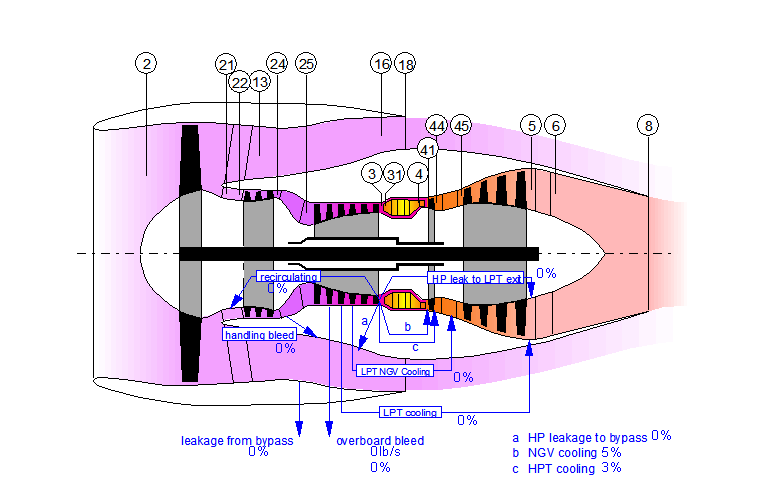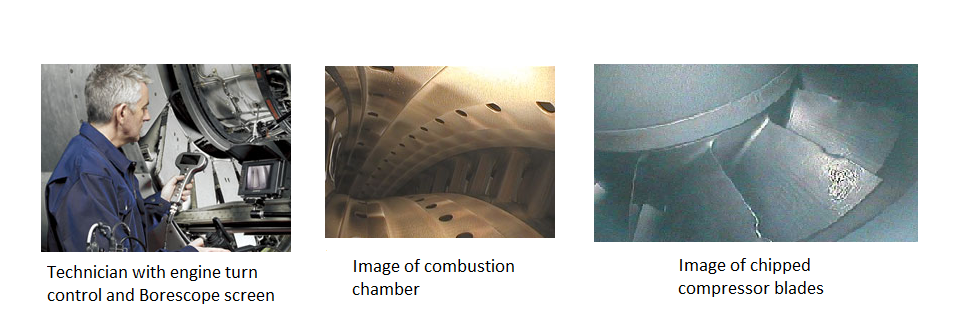Leeham News and Analysis
There's more to real news than a news release.
Bjorn’s Corner: Aircraft engines in operation, Part 5
February 17, 2017, ©. Leeham Co: In our journey of an airline engine’s life, we will now look at the maintenance which is necessary to keep it fit for flight.
An engine is only in top condition once in its life, at delivery. As soon as it’s operated on the aircraft, in-service wear of its different parts will reduce its performance.
The engine manufacturer’s prescribed maintenance is designed to keep the engine in good health during its life, despite all its hardship.
On condition maintenance
Traditionally, jet and turbofan engines for airliners were maintained on a fixed maintenance cycle. In addition to daily inspections, different repair actions were made at predetermined fixed intervals, irrespective on how the engine was used.
But the life of an engine is dependent if it’s operated on short hops in a hot and dusty environment or on longer sectors in a colder climate with clean air. Gradually, logging of data from the engines and better inspection procedures has allowed engines to pass to “On Condition” maintenance. On Condition means the engines are continuously tracked in their operational behavior and maintenance actions are triggered “when needed.”
Not all removals of a modern engine is based on On Condition events triggering a shop visit. The engines still have some hard limits, now more related to fatigue life of important parts than deterioration.
Engine cycles and Engine hours
When talking about engine maintenance, there are two usage parameters that are central: Engine Flight Cycles (EFC) and Engine Flight Hours (EFH).
The most important parameter for short-haul engines is the flight cycle (EFC). This comes from the engine’s high temperature exposure during take-off being the most stressing event for the engine.
For long-haul engines, the flight hour (EFH) can be more important, as the erosion and contamination of the engine gas paths can be more troublesome during the long flights rather than the infrequent takeoffs.
Hard limits
An important limit when discussing engine maintenance is the “Life Limited Parts” (LLP) limits on a number of vital parts of the engine. These are the fatigue-related limits that we highlighted before. Fatigue limits are extremely important as, e.g., a turbine disc fracture may happen.
When it still happens, it has severe consequences. The American Airlines Boeing 767 that had a turbine uncontained failure at Chicago O’Hare Airport last October was seriously damaged. Part of the failed turbine disc was found in an UPS warehouse 900m from the aircraft.
The LLP limits, which can be (for example) 20,000 flight cycles for the engine’s turbine blades and rotors, are dictated by fatigue mechanisms. These cannot be “On Condition” limits as there are no reliable methods to inspect for fatigue in an engine’s hot parts.
Instead, the certification authorities set limits with the engine OEMs for how long different stressed parts of the engine can be allowed to run. The limits for LLPs dictate when the engine shall be removed from the aircraft and do a “shop visit.” During the shop visit, the LLP sets which have reached their use limits are replaced.
A typical engine like our example CFM56-5B has 18 different sets of LLPs with life limits varying between 20,000 and 30,000 flight cycles (EFC). An important part of planning for engine shop visits is to manage the different times when parts of the aircraft’s engines need to be replaced. Ideally, exchange of LLP sets shall be coordinated when the engine is taken off wing for On Condition maintenance.
On Condition maintenance
The most important parameter for following the engine’s status is the Exhaust Gas Temperature, EGT. At delivery, the engine has a margin to an OEM-set highest EGT, called the EGT margin.
For the highest thrust variant in an engine series like the 32,000klbf CFM56-5B3 for the Airbus A321, the EGT margin can be e.g. 66°C at delivery. For the engine’s -B4 rating of 27,000klbf for the A320, the margin would be 109°C and for a 23,500lb variant (-5B6) 145°C. The higher EGT margin is the main reason lower rated engine versions stay on wing longer.
The engine would gradually increase the EGT at take-off as the engine deteriorates as described before (the engine’s computer compensates the deteriorated performance by injecting more fuel in the combustors to retain the take-off thrust). Gradually, the EGT margin is consumed by the aircraft’s flight cycles.
When the EGT margin is reduced to a minimum level, it’s time for a performance restoration shop visit. Dependent where the engine is in its life, there might also be LLP replacements scheduled at the same time.
Let’s say our engine is new and has run its first 10,000 cycles. The first shop visits would be to restore, e.g., parts of the hot section. The so-called “Workscope” could contain replacement of high pressure turbine blades and seals and repair of the turbine nozzle.
After the restore visit, a large part of the EGT margin comes back, but not all. The full EGT margin is only found on factory new engines.
Other parameters which are followed to decide on what maintenance the engine needs are oil sample analysis (to find mechanical problems) and visual inspections of the engine’s innards with Borescopes. On modern engines, a large number of other parameters from the engine’s control computer (FADEC) are also tracked.
Borescope inspections are done with special tools (flexible probes with CCD cameras and monitors) which are inserted in inspection ports on the engine. These allow the inspector so see how, e.g., combustor or turbine/compressor parts are worn by engine use, Figure 2.
Typical things the inspector would look for at the high pressure turbine blades would be (taken from the Borescope inspection manual for the CFM56):
- Blade trailing edge: Cracks
- Tip area: Cracks; Bent, curled, or missing pieces; Tip trailing edge wear.
- Blade platform: Nicks and dents; Cracks
- Concave and convex airfoil surface; Cracks; Distortion; Cooling holes plugging.
The inspection intervals for On Condition Borescope inspections are prescribed by the engine OEM. Should there be anything unusual in the engine’s behavior like:
- Fast increasing EGT
- Increasing imbalance
- Or any other FADEC parameter being out-of-normal
a Borescope inspection could be triggered to understand what is happening in the engine. This is often the first step before one decides to pull an engine for an unscheduled shop visit.





Thanks Bjorn,
Im wondering how different engines compare in terms of wear for example 2 vs 3 shaft etc. Is it true that GTFs wear more and what will future designs use to reduce wear, and care costs if anything?
“Borescope inspections are done with special tools (flexible probes with CCD cameras and monitors) which are inserted in inspection ports on the engine.”
There is an RR documentary on youtube whch features borescopes used in production. Its highy worth checking out that doc if u havent.
There is a well known effect of a three shaft engine being shorter and therefore less affected by mechanical bending effects at gusts and landings. This is good for all the fine tolerances of blade tips and seals, so three shaft engines normally deteriorate a little slower everything else being equal. But then GE claim that their GEnx deteriorate as slow as the Trent 1000, which could very well be as the “everything else being equal” doesn’t have to be equal. Only the airlines know.
Re GTF’s I have not heard they deteriorate faster. The Pratt & Whitney GTF gearbox is designed to function for the life of the engine without maintenance and has therefore insignificant wear.
Great learning for novices like me. Thank you.
Suggestion for one or two more articles:
i) Who are the best Engine Services/MRO/Component services players and a view of strength/weaknesses
ii) What are the typical steps an MRO shop (afi/klm, LH technik, etc) do in details when servicing an engine.
You all have a nice weekend.
Hi Ivorycoast,
good ideas, I plan to cover the MRO steps and market for both single and dual aisle engines.
Somewhat related to pegasusboots’ request, it would be interesting to see analysis of “competing” engine performance on the same or similar airframes in the way we sometimes get on the aircraft themselves – for example what is the actual experience on fuel burn and maintenance cost for V2500 vs. CFM56 or in a few years GTF vs. LEAP.
Tied in to the above, on the wide bodied side of things, Airbus and RR are linked closely as are Boeing and GE – to what extent do the strengths or weaknesses of the engine manufacturers hamper or help each airframer.
We do the kind of analysis you ask for but then on the paywall side or as consultancy assignments. This series is meant more like an light weight information service, covering the basics about engines and how these are used and maintained during their life.
Just a comment on T/O EGT deterioration: On Engines with N1(GE, CFM) as thrust setting the efficiency loss of in operation leads to a “double deterioration” , both a EGT increase and a thrust increase (Core engine thrust increase) adding EGT increase for a given N1 setting. For EPR (P&W) the thrust will decrease when engine deteriorates, this will in a way compensate for the EGT increase. . This is why P&W engines have much less EGT deterioration and is seldom removed for EGT.
Several decades ago we found that the 707 was below book performance on fuel efficiency.
And that some aircraft manuals used flight test data thus above minimum performance for takeoff – IIRC KLM published a manual for the Electra that adjusted performance downward. Later practice was to adjust performance downward to estimate engines in relatively well used condition. (I do not have any idea how Boeing figured that out, as engines on flight test aircraft would be in varying condition, I suppose they did final testing with engines carefully measured.)